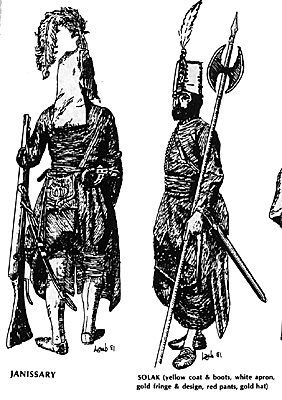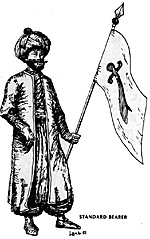
THE OTTOMAN STANDING ARMY
The heart and soul of the Ottoman military machine was the regular army long-standing troops who, like their Western contemporaries, were paid from the public treasury. The regular troops were known collectively as the "Kapu Kula"; the "servants of the Porte". The Kapu Kulu comprised five distinct branches of the military establishment - the famous Jannissaries, the Spahis of the Porte, the Topdjis or Artillery, Cebeci(armorers), and the Laganci (sappers).
Of these, it is the Jannissaries who have found lasting fame as one of the great "corps" of military history. Recruited since their inception from Christian children who were raised within the corps, by 1683 this was no longer the case and the jannissaries became increasingly Turkish in composition.
The corps was organized into three major subdivisions: Cemaat or Yaya - 101 OrtasBoluk - 61 Ortas; Segbah - 343 Ortas. Each of these haj hereditary "regimental" customs and ceremonial functions. The heraldic devices of each Orta may provide some clue of their original function (see illustration of standards in the next issue).
The Orta was the smallest tactical unit of the Jannissaries, though the possibility exists of smaller 20-man subsections similar to the Spahis of the Porte. The Orta had no standard strength, though 400-500 would be the ideal. On campaign, the average number of men could be 125-250.
The weapons of the Jannissaries were musket with a particularly long range, some using a flint-firing system; pistol, saber and daggers. All were beautifully jeweled and individually crafted with artistic designs or religious inscriptions. Powder for the muskets was stored in a horn slung from the belt and was of excellent quality; saltpeter being in plentiful supply in Egypt. Armor was no longer used.
The overall Corps was commanded by an Aga, usually also the commander of the Cema'at assisted by the commanders of the Baluk and Segmani, then deputies and various minor officials. Each Orta was commanded by a Corbachi, assited by other officers known as Odabasi and Vekilhures, the exact number of each per Orta is unknown.
The Jannissaries were drilled regularly and marched into battle with a band (the mehterhune). The style of fighting is open to some interpretation; though trained troops, the individual style of fighting permeated the Ottoman army to its detriment. the Jannissaries were probably capable of sustained opening volleys, but the interior layers of command were too few too employ the section of Western armies. It is for this reason that in our period the Jannissaries, like most Ottoman infantry, fought behind field fortifications. These would include wide firing trenches and two step parapets.
This permitted increased fire control as alternate ranks could step up to the parapet to fire as others loaded, and being able to recline, facilitated aiming the muskets. In melee, the Jannissary was an excellent swordsman, but having no other melee weapon he stood rather helpless in the face of cavalry, another reason for the continued reliance on field defenses.
An analogy can be drawn between the Jannissaries and the Highlanders of the various Jacobite rebellions. Both individually were superior in melee to their more formal opponents, but as a unit the cohesiveness breaks down. Another factor was the eventual introduction of the bayonet (first plug, then ring, then socket), each increasing the melee value of the Ottoman's Western counterpart while maintaining the ability to fire.
The quality of the Jannissaries in this period underwent a decline first because of the influx of native Turks more interested in the lucrative economic benefits than the truly martial aspects. Seconcilly, the level of weapon technology continued to lag behind that of the West. Third, outmoded tactical methods; and lastly, a presumptuous Praetorian attitude of staging mutinies for political and monetary benefits. The old valor remained, but the motives became more self-indulgent.

Garrison Jannisaries
Besides the Ocak, or original Corps of Jannissaries, there existed the Garrison Jannissaries of the Balkan provinces.
Though some critics argue that the settled attitude of these Jannissaries saw a decline in their fighting ability; being on the "front line," so to speak, their practical knowledge of war was at least as high as most line units of the West They would be equipped and armed like the regular Jannissaries, though possessing certain quantities of captured arms. Next to be considered are the Egyptian Jannissaries who make and appearance in the Russian campaign of 1711.
These were raised by the Pasha of Cairo in imitation of the Sultan's own. They were of lesser qualifly than the other two corps, being newly raised in an area where anyone of importance rode to war. The weapons were antiquated, namely bow, scimitar, possibly shield, a few might posses matchlocks or arquebuses.
In the Ottoman army of the horse and musket period, only the Serdengecti (those who give up their heads) maintained the old elan. They were the equivalent of grenadiers and were formed from the Ortas into their own companies who received the hazardous duties and received extra pay.
During the Seige of Vienna, each arduous attack against a mined breach was carried out by Jannissaries. Unlike previous campaigns where the initial attack was made by Bashibazouks and Arabs, by the mid 17th century the attack was conducted by the Jannissarries. A prisoner taken during an Austrian sortie declared the seige cost 11,000 Jannissaries, perhaps the old esprit de corps was not quite lost.
THE SPAHIS
"L'arme blanche" of the Ottomans was and remained, well into the period under discussion, the household cavalry of the Porte, the Spahis.
The term "Spahis" is confusing, as is most of the mass of Ottoman nomenclature. The "Spahis" refered not only to the entire household cavalry, but to the first "regiment" also. The Spahis (generic) were composed of six "regiments", each divided into 20 man sections. They were composed of the wealthiest retainers and most important families of the realm.
The first two regiments titled the Spahis (specific) and the Silahdar were grouped together to form the Grand Vizierial Bodyguard. These were the best armed and trained of the entire Corps. Their flags were yellow and red respectively, on each flag were two silver cresents. the flags were pennant shaped. The third and fourth units were termed the Oluteci (mercenaries). Their standards were red-and-white and yellow-and-white striped, respectively and the shape, I believe, was square. The last two regiments were the Guraba (foreigners), probably Persian and Arab, or by this time even Marnalukes, as such they probably retained some measure of horse barding and bows instead of carbines. Standards were green and white, although one flag is of nine stripes, green over white.
On the subject of weapons, it is best not to be dogmatic. Each spahi was equipped according to personal choice, probably the Silahdars and Spahis were equipped with pistols and carbine; the others and all retainers with bow. Cane or wicker shields were found after the seige of Vienna covered with leather or woven silk. All carried a long pennanted lance and "kilig" or curved saber.
Horse trappings left behind after the seige were found to be merely decorative, rather than offering any protection to the bearer, but Persians, etc., may have had barded horses.
The Spahis were usually kept in reserve, behind the main lines and were used as a last trump in battle. At the Kalenburg, the spahis charged the steady Ines of Austro-German infantry and, though they failed to break them, the Austrians were shaken and currasiers were ordered up behind the infantry to bolster the lines. Later in the day, they repulsed several charges of the Polish winged hussars, requiring the latter to reform behind steady German infantry.
The spahis were also, at least by Malta in 1564, required to serve in the trenches with their servants, who aided in sapping. Their ability with the sword would have served them well in the close quarters of trench fighting.
ARTILLERY AND ENGINEERS
By 1683, the Topdjis or Ottoman regular artillery were no longer the modern and respected military branch they had been in the 15th and 16th centuries. This decline was due to several reasons. First, the state of fortress architecture in the west had improved, along with theories of attack and defense of such new constructions.
Second, the Ottoman artillery was notoriously outdated, even though a contemporary Ottoman picture shows wheeled gun carriages - this probably represents a captured Austrian field gun, of which several would be present. Other sources of "modern" equipment would be several pieces purchased from English and Dutch merchants.
The majority of the Ottoman artillery ranged a wide span of sizes, there being no uniformity in calibers or ammunition supply. 250 heavy cannon were present at Vienna for the prosecution of the Seige. Most were bronze cast set on a heavy limber with unweidly solid wheels. Once placed in position, they would be almost impossible to relocate.
Lighter guns would be borne by camels, though as beast of burden, rather than camel-gunners a la the Moghul or Mamaluke armies. The supplying of a variety of guns was further complicated by the Ottoman penchant for using all captured artillery in their siege forces. Victorious Christian troops after the lifting of the siege found Polsh, Russian, Venetian and Persian guns in the siege lines. Strangest of all was the use even at this late date of catapults, employed to hurl massive granite stones. Forty were abandoned by the Ottomans at Vienna.
Except for fires, which were brought quickly under control, the artillery bombardment was more a nuisance than anything else. The true forte of the Ottoman army during the siege was mining. It was the multitude of mining operations - at one time eleven different mining saps were under construction, one of which was discovered in the basement of the Spanish ambassador's residence, which nearly spelled defeat for the defenders.
Mining operations were completed under the guidance of the Aga of the Jannissaries.As most of the labor and the main assault force was provided by the Jannissaries, this was perhaps a ceremonial, as well as practical, honor. The best miners in the Ottoman army were the Armenians, who supervised the actual construction and laid out the direction of each sap.
The actual mine galleys were narrow compared to the West's counter-mining tunnels, but the impact blast was more concentrated.
Siege lines were constructed by the entire entire army, all elements, including the Spahis doing a turn in the trenches. The trenches were laid in a gridlock fashion, usually concentrating on one particular force of the enemy fortress. By the Siege of Vienna, many of the more experienced engineers had been killed off before the epic siege of Venetian Canadia on the island of Crete. this and the poor sighting of siege artillery put the main emphasis of Ottoman attacks on mining. Nighttime assaults were not unknown and Cacavelas records them as being coordinated by signal rockets. For assaults on enemy postions, hand grenades were also used, 2,000 iron and 18,000 brass grenades being left behind when the siege was abandoned.
More Ottoman Army at Vienna
-
Ottoman Army at Vienna Part 1: Introduction
Ottoman Army at Vienna Part 1: Army Organization
Ottoman Army at Vienna Part 2: Standards and Flags
Ottoman Army at Vienna Part 2: Irregular Forces
Ottoman Army at Vienna Part 2: Christian Foe
Ottoman Army at Vienna Part 2: WRG Army List
Related
-
Turkish Delights: Using the Ottoman Turks in the Napoleonic Period 1795-1815
Using Ottoman Turks on the Wargame Table
Back to Table of Contents -- Courier Vol. III #3
To Courier List of Issues
To MagWeb Master Magazine List
© Copyright 1981 by The Courier Publishing Company.
This article appears in MagWeb (Magazine Web) on the Internet World Wide Web.
Other military history articles and gaming articles are available at http://www.magweb.com